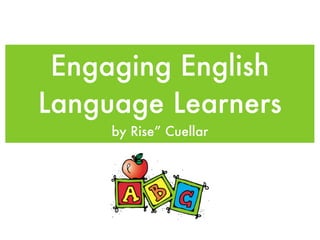
Ell presentation
- 1. Engaging English Language Learners by Rise” Cuellar
- 2. Student Engagement • All students need to be engaged in the lesson in a fun and interesting way. • ELL students especially need this to help bring their language to life. • This is done at the beginning of a new theme or topic or as an introduction to a lesson.
- 3. HOW? • Short and snappy. • Not more than a few minutes. • You want to grab their attention.
- 4. Sing songs or chants. Read poems with visual support.
- 5. Visual Support Examples Stuck On A New Word? Look at the pictures -Look at the picture for clues Get your lips ready -Say first sounds • Photos -Read & say it again Stretch it out -Stretch word out -Put sounds together • Posters Chunk the Word -Look for word chunk -Look for a word part • Real objects Skip It, Skip It -Skip the word -Read to the end -Hop back & read it • Charts Try it again -Try to reread -Try a new word Ask for help -Ask for help after you have tried the other strategies Never let the word win. Read on!
- 6. Read Short Interesting Books • Act out actions. • Sketch key vocabulary. • Reread the story the next day. • Work on a theme or topic with several books during the unit.
- 7. Selected Passages • Choose a few pages from a book to grab attention • The pages should contain clear pictures.
- 8. Read and act out: • Stories and simple plays with straightforward plots. • Various scenarios of everyday interactions. • Teach frequently heard words.
- 9. T U • Model the rhythm and cadence of the N English language through reading: E • interesting passages T H • poems E • short stories E A R
- 10. Recreate scenarios or retell stories through actions, drawings, and sentences using frames they complete with learned words and phrases.
- 11. Writing Write sentences of common utterances and read them aloud.
- 12. Write then Read • Write--One word at a time so students see and hear words. • Read--Slowly as a whole, then at normal speaking speed.
- 13. Use known works to focus on phonological awareness. Make this brief and lively!
- 14. Language Pattern Songs • Use Language Pattern Songs to engage students at the beginning of a lesson. • These help the students to practice the vocabulary, language patterns and cadence.
- 15. Sing a New Song • It tunes the ear to a language pattern. • Helps to internalize the new language.